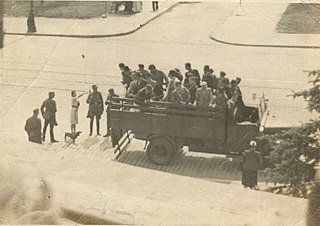Łapanka
| Łapanka | |
|---|---|

|
|
| Location | German-occupied Europe, predominantly Nazi occupied Poland |
| Period | World War II (1939–1945) |
A roundup (Polish: łapanka, [waˈpanka]; French: rafle or attrapage) was a widespread Nazi German World War II military tactic used in occupied countries, especially in German-occupied Poland, whereby the SS, Wehrmacht and RSHA ambushed at random thousands of civilians on the streets of subjugated cities for enforced deportation. The civilians were captured in groups of unsuspecting passers-by, or kidnapped from selected city quarters that had been surrounded by German forces ahead of time.
People caught in roundups were most often sent to slave labor camps in Germany, but also taken as hostages in reprisal actions, imprisoned and sent to concentration camps, or summarily executed in numerous ethnic cleansing operations.
The term łapanka comes from the Polish verb łapać ("to catch") and, used in this context, carried a sardonic connotation from its prior use as the name for the children's game that is known in English as "tag".
"Round ups, or lapankas, the Polish name they were known under, became an essential feature of life in Warsaw and precipitated much wider ferocity on both sides. (...) Whole streets were sealed off by police and soldiers and most trapped men and women were carted off to concentration camps or sent as slave labour to the Reich. Tram and trainloads of people, regardless of work documents, were herded like cattle into trucks, many never to see home or family again." - Ron Jeffery memoir, 1943
Most people who were rounded up were transported to labor camps (Arbeitslager), including Auschwitz. Many Polish women were selected for sexual slavery. Many Polish children were kidnapped for adoption by German families. Some − those without proper documents or carrying contraband − were transported to concentration and death camps. Others, particularly Jews in hiding and Poles wanted for harboring them, were shot dead on the spot.
...
Wikipedia
